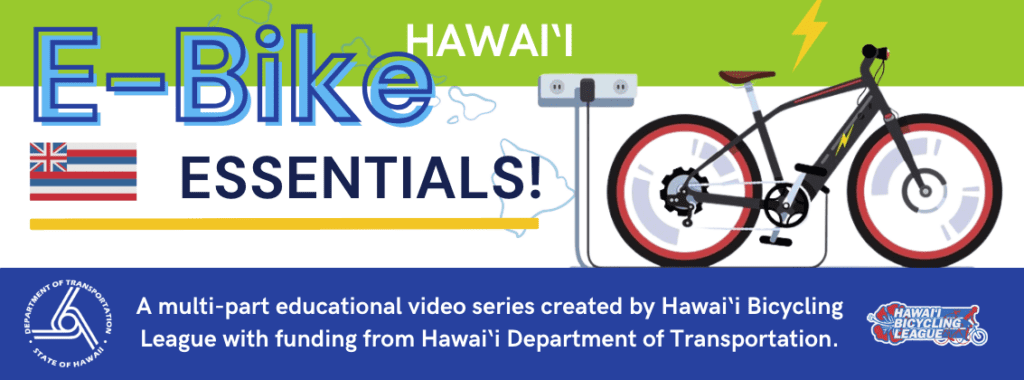
Learn what is considered an e-bike in Hawai‘i (and what is not), where they can be operated, and what sets them apart from traditional bicycles.
E-bikes are helping to get more people on bicycles by breaking down barriers to bikes – making longer-distance commutes more attainable, giving the ability to haul heavy cargo, flattening hills, and reducing physical restrictions, time, and sweat for those looking to ride.
Key takeaways
E-bikes in Hawai‘i are 2- or 3- wheeled vehicles that have fully-operable pedals and an electric motor that is under 750 watts and stops providing assistance at 20 MPH.
- If it meets these criteria, it is considered a low-speed electric bicycle in Hawai‘i and can be registered to be ridden on public roadways & bike facilitates, just like a traditional bicycle.
- The minimum age to legally ride an e-bike in Hawai‘i is 15.
Thinking about getting an e-bike? Here are five tips to help you make an informed decision when purchasing an e-bike in Hawai‘i.
- Understand your needs – Think about what you intend to do with your e-bike – this is a helpful starting point to help you choose a style/type of e-bike that best first your lifestyle & needs.
- Consider your budget – While there are more & more affordable e-bikes on the market, price often does reflect quality and you get what you pay for. You may qualify for up to $500 off; check out HDOT’s electric bicycle rebate here.
- Where will you be storing your e-bike? It’s best to keep your investment inside, out of the elements. If you have stairs or need to transport your e-bike you may want to look at lighter or space saving options.
Key takeaways
- Buy it local or ship it over? Online shopping offers more options for e-bikes but may result in major headaches when it comes to shipping & serviceability. By purchasing your e-bike through a local bike store you’ll have the benefit of being able to take it in for repairs & service, getting to test ride it, and supporting local business.
- Do your research – Familiarize yourself with Hawai‘i’s regulations regarding e-bikes. Some bikes sold in stores & online are intended for off-road use only, so do your due diligence ahead of time by brushing up on local laws & making sure you are buying a bike that is safe, street-legal, matches your needs, and not stolen.
Where are e-bikes allowed? This video covers where e-bikes can be ridden in Hawai‘i and best practices when sharing the road with others.
- When operating on public roads, make sure to follow all rules of the road. Cyclists, including e-bike riders, are safest when they act & are treated as, drivers of vehicles.
- Ride in a predictable manner with respect for others safety.
Key takeaways
- E-bikes are allowed anywhere a traditional bicycle is permitted – on all roadways (except for freeways) and in all bicycle facilities.
- Follow general rules of the road. Yield to pedestrians, stop at red lights & stop signs, obey posted speed limit signs, and go with the flow of traffic.
Our friends at the Honolulu Fire Department share top five e-bike charging tips that can help prevent dangerous lithium-ion battery fires but also help prolong the range of your e-bike.
Lithium-ion batteries are very safe, however, problems can occur with damaged or defective batteries and overcharging. Taking good care of your e-bike battery is important in order to prevent your e-bike battery starting a fire.
Follow the manufacturer’s guide for charging, storing, and handling your e-bike battery and battery system.
Charge your e-bike battery plugged directly into a wall outlet. Never use charging strips or extension cords.
Avoid charging or storing your e-bike battery in extreme temperatures.
Do not modify or attempt to repair your e-bike battery or battery system.
Key takeaways
- Review the owner’s manual (or check out the manufacturers site). Always follow the manufacturer’s instructions when charging, storing and maintaining your e-bike battery.
- Never charge a damaged battery. Check for any cracking, leaking, or bulging.
- Always use compatible batteries and chargers.
- Choose a cool, well-ventilated area outside of the house.
- Charge only when you are present in a safe area, away from flammable materials.
To view an E-Bike Battery Safety FAQ sheet from PeopleForBikes click here.
While e-bikes can look a lot like the bicycles you grew up with, there are some crucial differences that you need to know to stay safe and have fun with your e-bike. Check out HBL’s top 5 tips to bring you up to speed before you get to speed with your new electric vehicle.
Safe, smart cycling starts before you get on the bike.
- Protect your head! Check out this short video on how to fit your helmet properly here.
- To legally operate an e-bike in Hawai‘i you must be at least 15 years old.
- A heavier & faster vehicle requires more time to come to a stop, so keep a hand on the handlebars at all times and be ready to brake earlier.
- Do your pre-ride safety check. View a short video on how to do the ABC Quick Check here.
Key takeaways
- Get to know your e-bike – read the owner’s manual and ensure you’re familiar & comfortable with it’s features and operation – before getting on the open roads.
- Start SLOW. Test ride the bike in an area away from others, starting with the lowest power setting to get a feel of how the bike responds/handles. After that you can gradually increase the power levels as you feel comfortable. Only go as fast as you can control.
- The higher the speed the higher the risk and more alert & tuned in you have to be.

